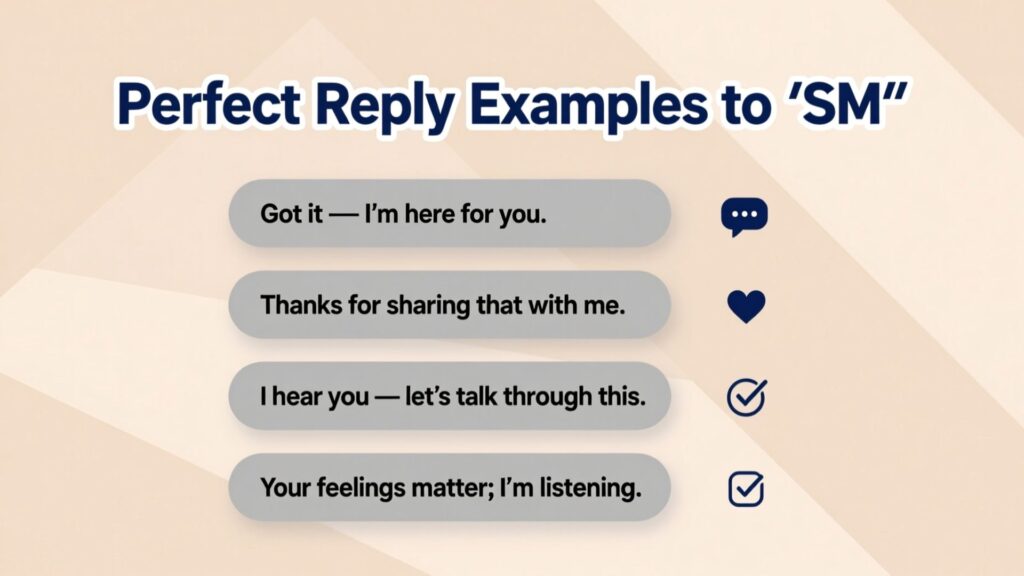Introduction: The Rise of Text Shortcuts in 2025

In our fast-moving digital world you see abbreviations everywhere. One two-letter pair “SM” has popped up in chats, comments and texts more often than you might realise. But what does SM mean in text? And why does it matter?
For many people, “SM” serves as an emotional shorthand (“I love you sm”), or as a professional shorthand (“Upload this to our SM channels”). But if you don’t know the context you could easily misread it.
In this article you’ll learn: actual meanings of sm meaning in text, how to tell which one applies, when to use it (and when to avoid it), plus real-life examples and tips you can apply immediately.
What Does “SM” Mean in Text?
When you ask, what does SM mean?, the answer isn’t always simple. “SM” is an abbreviation used in digital chats and texting to save time or space. But it covers multiple meanings, depending on the situation.
At its core, sm in text most commonly means “so much”. But there are several alternate meanings each with its own tone and platform. Knowing the meaning behind “SM” helps you communicate clearly.
“SM” as “So Much”: The Most Common Meaning
When people use sm meaning text as “so much”, they’re emphasising intensity or volume of something. Usually it’s emotional. You might see:
“I love you sm ❤️”
“Thanks sm for being there”
“Miss you sm!”
These are casual, friendly, personal uses. The person texting wants to show genuine feeling and “sm” fits in with today’s digital shorthand.
Because it’s informal, this meaning works best with friends, family or folks who know your style.
Alternate Meanings of “SM” in Different Contexts
SM = Social Media
In professional or marketing contexts you’ll commonly see SM meaning social media platforms like Instagram, TikTok, X (Twitter) and Facebook.
Example:
“Please schedule the next campaign in our SM calendar.”
Tone: marketing, business, professional.
SM = Send Me
Another meaning: Send Me. This one pops up in informal chats where someone requests something quickly (photos, location, link). Example:
“SM the link?”
This use is casual and direct not ideal for formal writing, but common among friends or team chats.
SM = Short Message
A less common but literal meaning: Short Message (from texting history). While you’ll rarely see this in everyday chat, it appears in tech or telecom discussions. For instance: “We need to audit all SM traffic this month.” However this usage is fading.
SM = Sado-Masochism
In very niche or adult contexts, SM can refer to sadomasochism (also seen as “S/M”).
This meaning is very context-sensitive. If you’re not sure whether “SM” refers to that, don’t assume check the conversation topic and audience.
How to Identify What “SM” Means from Context
When you see “SM” in a message, use the following three-step framework to decode the meaning:
- Check the tone – Is it emotional/personal, business/corporate, or niche/adult?
- Look at the topic – Are you chatting about feelings, work, content, or something more specialised?
- Observe the platform – A casual chat app vs. a workplace Slack vs. a forum all matter.
Here’s a table to illustrate:
| Chat Type | Example | “SM” Meaning | Tone |
|---|---|---|---|
| Personal text | “Miss you sm!” | So Much | Friendly, emotional |
| Work group chat | “Review the SM plan today.” | Social Media | Professional |
| Casual friend chat | “SM the pic pls” | Send Me | Informal |
| Adult forum/discussion | “Interested in SM?” | Sadomasochism | Niche, adult |
This table helps you quickly evaluate what the abbreviation likely stands for.
Why “SM” Can Be Misunderstood
Because “SM” means multiple things, you can easily misread a message. Here are some common scenarios and mistakes:
- Using “SM” in a formal email when you mean “so much” the recipient might interpret it as “social media” or think you’re being too casual.
- Responding assuming a meaning (e.g., “Send me” vs “So much”) and missing the intended message.
- Audience mismatch Younger people might know “sm” as “so much”; older colleagues might think “social media”.
That shows how even within the same platform different users guess different meanings.
When to Avoid Using “SM”
There are times when even if you know what “SM” means you should steer clear. Consider avoiding “SM” when:
- You’re writing in a formal or professional setting (business email, legal doc, public statement).
- Your audience might not know the slang e.g., older readers, non-native speakers, or people outside your social circle.
- You’re dealing with sensitive topics (grief, conflict, serious feedback) where clarity is essential.
In those situations, spell things out: “so much”, “social media”, “please send me”, etc.
Polite & Professional Alternatives to “SM”
When “SM” feels too casual, here are better options. They help you keep tone and clarity without losing style.
Casual Conversations
- “so much”
- “a lot”
- “tons”
- “really much”
Professional Settings
- “very much”
- “greatly”
- “significantly”
- “please send me” (instead of “SM”)
Emotional & Personal Chats
- “I love you so much”
- “I appreciate your help deeply”
- “You mean a lot to me”
Online/Text Slang Equivalents
- “ily” (I love you)
- “ikr” (I know, right)
- “fr” (for real)
Choosing the right alternative makes your message both clear and appropriate.
15 Perfect Reply Examples to “SM” in Text

Here are real replies you can use when someone texts you “SM”. They’re sorted by tone for ease.
Affectionate Replies
- “Aww, love you sm too!”
- “Miss you sm right now 😢”
- “Thanks sm for always being there.”
Friendly Casual Replies
- “Thanks sm, you’re awesome!”
- “That means sm to me.”
- “Got it will send it sm.”
Funny Replies
- “SM? You meant Starbucks money right?”
- “SM? I thought you meant same message 😂”
- “SM… like Santa’s magic?”
Professional Replies
- “Thank you very much for your help.”
- “I’ll review the SM strategy today.”
- “Please send me (SM) the document by EOD.”
Neutral/Informal Replies
- “Cool see you sm.”
- “SM the link when you can.”
- “I’ll catch up sm tomorrow.”
These replies keep your tone in check while still mirroring the meaning.
How “SM” Reflects the Evolution of Digital Communication
Abbreviations like sm in text highlight how digital talk keeps adapting. A few observations:
- In 2010–2015 texting shortcuts emerged mainly because of keypad limitations.
- By 2025 people expect speed, brevity and emotional punch in messaging.
- The same abbreviation can live contemporaneously in personal, professional and niche spheres something that didn’t happen as much a decade ago.
- Younger generations now shape what becomes acceptable shorthand; “sm” is one such example.
This evolution means you’ll keep seeing new slangs, but the same rules apply: know your audience, read the tone, and choose words intentionally.
Common Mistakes When Using “SM”
Here are pitfalls to avoid:
- Overusing “SM” in multiple messages so it loses meaning (“Thanks sm, love you sm, miss you sm…”).
- Assuming everyone knows what you mean the recipient might read a different meaning.
- Neglecting punctuation/capitalisation “SM” (all caps) sometimes signals a different meaning than “sm”.
- Using it in serious contexts If the message is a solemn update or official communication, avoid “SM”.
- Mixing meanings inadvertently e.g., in a marketing chat you type “hello sm” meaning “so much” but your team thinks “social media”.
Avoiding these ensures your communication stays clear and fits the context.
Expert Tips for Using Text Slang Responsibly
- Pause and reflect: Before hitting send, ask “Will the recipient know what I mean by ‘SM’?”
- Match your audience: With friends go casual; with colleagues go clear.
- Use full words when in doubt: Better to be understood than trendy.
- Stay aware of tone: If your message includes sensitive content, skip the slang.
- Watch evolving trends: Language shifts fast. What’s common today might feel outdated tomorrow.
Using acronyms like “SM” can show you’re in the loop just don’t let them jeopardise clarity.
Quick Recap: SM Meanings at a Glance
Here’s a quick table summarising the main meanings of “SM” and when to use them:
| Meaning | When to Use | Avoid When | Example |
|---|---|---|---|
| So Much | Casual, emotional texts | Formal or business communication | “Thanks sm for your help!” |
| Social Media | Content, marketing, business contexts | Personal chats with non-digital crowd | “Please schedule on our SM channels.” |
| Send Me | Quick requests among friends/colleagues | Formal emails or messages with seniors | “SM the file pls.” |
| Short Message | Tech/telecom discussions | Everyday chat | “Monitor SM traffic.” |
| Sadomasochism | Adult conversations, niche forums | General texting, professional chats | “Interested in SM?” |
Conclusion: Decoding “SM” the Right Way in 2025
By now you know exactly what does SM mean in text and why the meaning depends on context. Whether you encounter sm meaning text as “so much”, “social media”, “send me”, or something niche your job is to ask: Who, where and why?
You can use “SM” to sound casual, modern and expressive. Or you can skip it for clarity when it matters. The key is understanding the audience and the tone.
So next time you see “SM” in a chat, you won’t be left guessing. Instead you’ll read the message, know the likely meaning, and respond with the right tone. And that makes your digital communication sharper, smarter and more effective.
Go ahead send that message, post that reply, and use “SM” when it really fits.
Bugti is the founder of Quoethint.com, a hub for English language tips, writing advice, and grammar guidance. With years of experience in English studies and a passion for clear communication, Bugti created this platform to make grammar and writing easy to understand for everyone.
